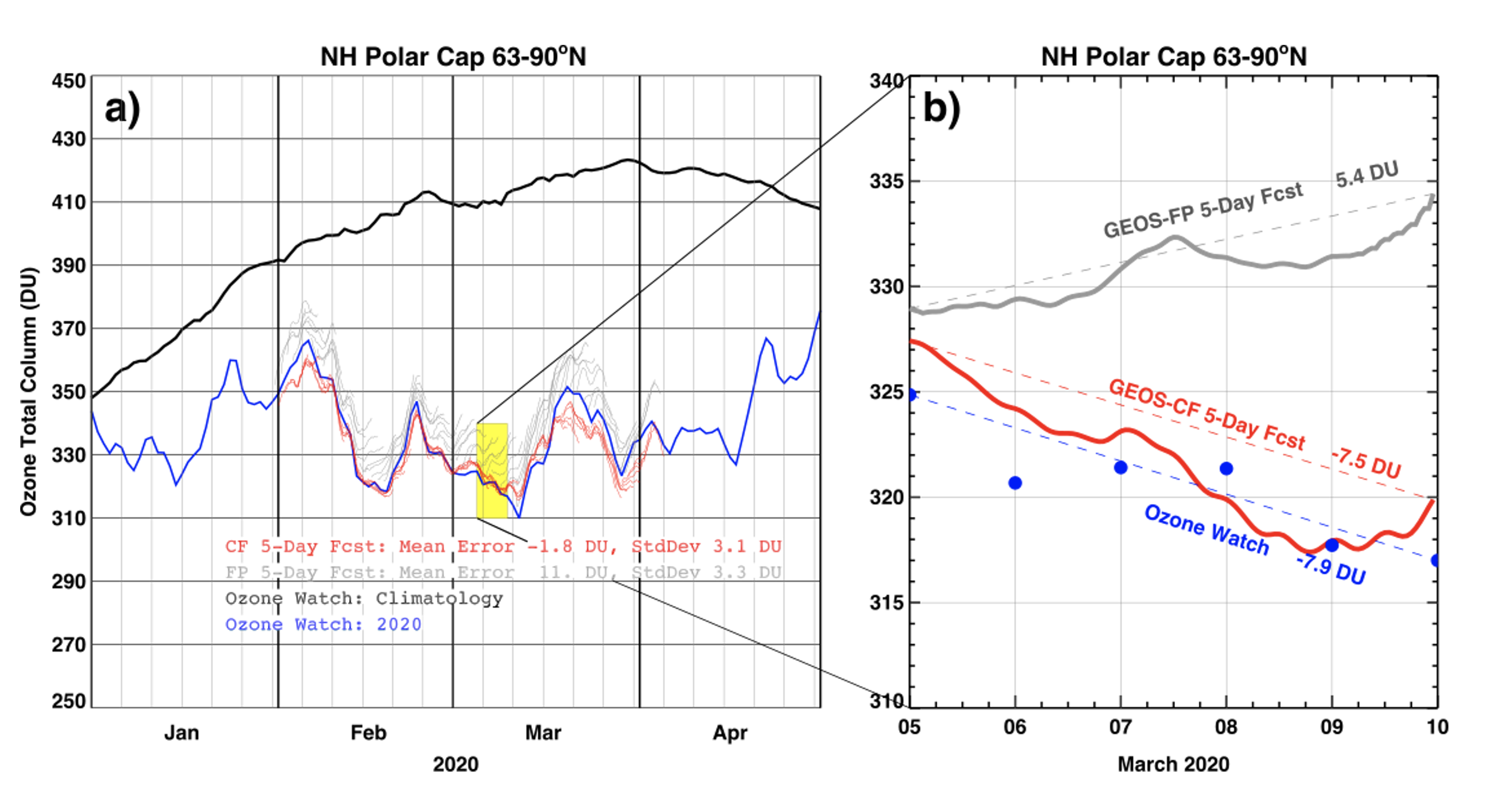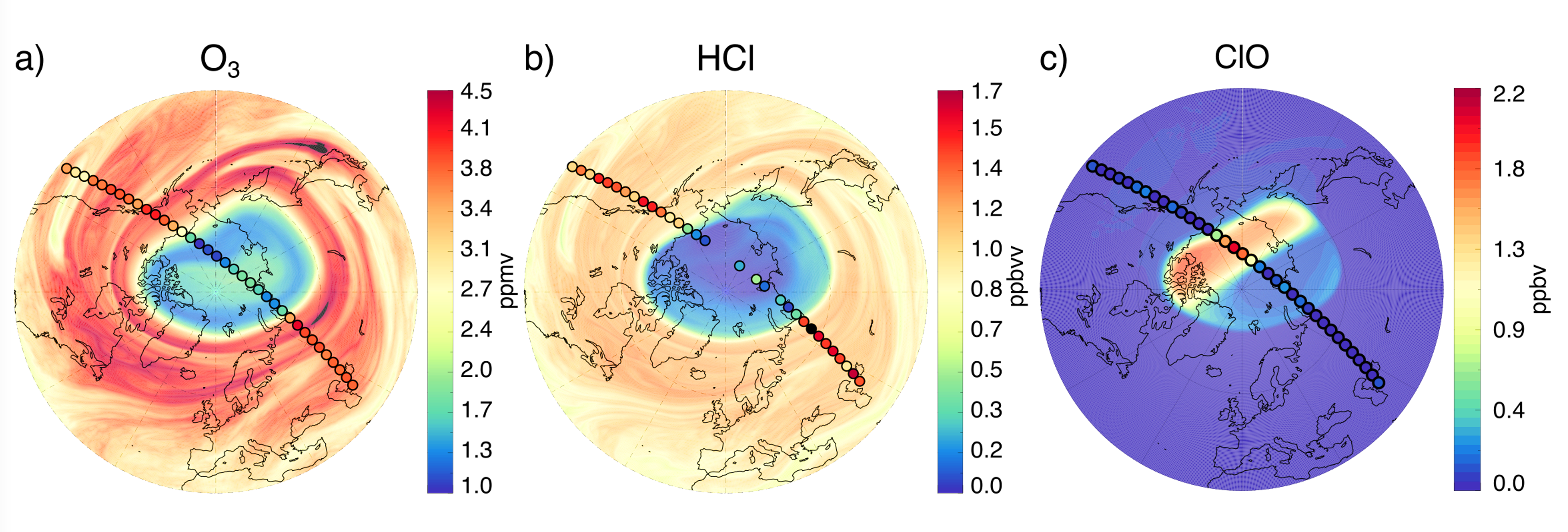Stratospheric Ozone Forecasts are Realistic when using the Chemical Mechanism in the GEOS-CF System
NASA’s Global Modeling and Assimilation Office (GMAO) produces high-resolution global forecasts for weather, aerosols and stratospheric ozone with the state-of-the-science numerical weather prediction GEOS Forward Processing system, “GEOS FP”. The NASA GEOS model has been expanded to provide global near-real-time 5-day forecasts of atmospheric composition through the GEOS Composition Forecast system, “GEOS-CF” (Keller et al., 2021). The GEOS-CF system combines the operational GEOS numerical weather prediction model with GEOS-Chem, a complex atmospheric chemistry model, to produce detailed analysis of a wide range of constituents on the same spatial and temporal resolution as the meteorology. Therefore, the GEOS-CF products can be used to support NASA missions that measure trace gases in the troposphere and the stratosphere, such as for ground-based, balloon, and satellite-based instrument teams, as well as field and aircraft campaigns (Dacic et al., 2020; Gronoff et al., 2021; Johnson et al., 2021; Lee et al., 2021; Bernier et al., 2022; Sullivan et al., 2022).
In the stratosphere, the ozone layer protects life on Earth from harmful ultraviolet, “UV’, radiation. Chemical loss of this protective ozone occurs in the stratosphere, but it is especially intense during springtime over Antarctica and occasionally over the Arctic when air over these regions are cut-off from the rest of the stratosphere because of the strong winds blowing circularly around the pole. For accurate forecasting of the ozone layer and UV, it is critical to have both meteorology and chemistry accurately represented in forecast models. The GEOS FP system assimilates total column ozone (TCO) from the Ozone Monitoring Instrument (OMI) and the Ozone Mapping and Profiler Suite (OMPS) and ozone profiles from the Microwave Limb Sounder (MLS) instrument for realistic analyzed ozone fields; however, the GEOS FP forecasts rely on simple parameterized chemistry which fail to predict TCO when far from climatological values, such as occurred in the Northern Hemisphere polar region during winter and spring 2020 (Figure 1a; Knowland et al., 2022). The example for March 5, 2020 (Figure 1b) demonstrates that the GEOS-CF forecast was later verified to be in good agreement with NASA’s daily observation-based Ozone Watch analysis of TCO that decreases over the 5-day forecast period, in contrast to the GEOS FP system, which was trying to project the TCO toward the climatological average which in March is about 400-450 DU. Since the GEOS-CF is nudged toward the GEOS FP analyzed ozone fields, both forecasts start at a similar place, however, during such anomalous dynamic and chemical events, the complex stratospheric and tropospheric chemistry package used in GEOS-CF is responsible for the improved ozone forecasts.

Within the polar vortex, the heterogeneous chemistry can lead to substantial destruction of stratospheric ozone. This is demonstrated in the snapshot of the NH polar vortex on 5 March 2020 at 22 UTC, comparing GEOS-CF simulated concentrations to measurements from a single MLS overpass (Figure 2). It is no surprise that the NH ozone agrees well to MLS observations in Figure 2a since GEOS-CF at 45 hPa is nudged toward the GEOS FP assimilated product. Presented here is how GEOS-CF can simulate the location and chemistry of the vortex: While GEOS-CF underestimates the observed high values of hydrogen chloride (HCl) outside the vortex (panel b) and the highest chlorine monoxide (ClO) values within the sunlit portion of the vortex (panel c) as seen by MLS, it successfully captures the timing and location of chlorine activation that drive the anomalous ozone loss over the Arctic, as indicated by the low HCl and high ClO mixing ratios.

During the NH 2020 winter, when there was record-low column ozone associated with a strong polar vortex, the near-real-time GEOS-CF system proved to be especially useful in such situations when the vortex containment and chemistry drive stratospheric ozone far from climatology (Knowland et al., 2022).
References
Knowland, K. E., C. A. Keller, P. A. Wales, K. Wargan, L. Coy, M. S. Johnson, J. Liu, R. A. Lucchesi, S. D. Eastham, E. Fleming, Q. Liang, T. Leblanc, N. J. Livesey, K. A. Walker, L. E. Ott, and S. Pawson. 2022. NASA GEOS Composition Forecast Modeling System GEOS‐CF v1.0: Stratospheric composition. Journal of Advances in Modeling Earth Systems, 14 (e2021MS002852): [10.1029/2021ms002852]
Keller, C. A., K. E. Knowland, B. N. Duncan, J. Liu, D. C. Anderson, S. Das, R. A. Lucchesi, E. W. Lundgren, J. M. Nicely, E. Nielsen, L. E. Ott, E. Saunders, S. A. Strode, P. A. Wales, D. J. Jacob, and S. Pawson. 2021. Description of the NASA GEOS Composition Forecast Modeling System GEOS‐CF v1.0. Journal of Advances in Modeling Earth Systems, 13 (4): [10.1029/2020ms002413]
For more information on the GEOS-CF model set-up and for access to model output visit https://gmao.gsfc.nasa.gov/weather_prediction/GEOS-CF/
Bernier, C., Y. Wang, G. Gronoff, T. Berkoff, K. E. Knowland, J. T. Sullivan, R. Delgado, V. Caicedo, and B. Carroll. 2022. Cluster-based characterization of multi-dimensional tropospheric ozone variability in coastal regions: an analysis of lidar measurements and model results. Atmospheric Chemistry and Physics, 22 (23): 15313-15331 [10.5194/acp-22-15313-2022]
Dacic, N., J. T. Sullivan, K. E. Knowland, G. M. Wolfe, L. D. Oman, T. A. Berkoff, and G. P. Gronoff. 2019. Evaluation of NASA's high-resolution global composition simulations: Understanding a pollution event in the Chesapeake Bay during the summer 2017 OWLETS campaign. Atmospheric Environment, 117133 [10.1016/j.atmosenv.2019.117133]
Gronoff, G., T. Berkoff, K. Knowland, L. Lei, M. Shook, B. Fabbri, W. Carrion, and A. Langford. 2021. Case study of stratospheric Intrusion above Hampton, Virginia: lidar-observation and modeling analysis. Atmospheric Environment, 118498 [10.1016/j.atmosenv.2021.118498]
Johnson, M. S., K. Strawbridge, K. E. Knowland, C. Keller, and M. Travis. 2021. Long-range transport of Siberian biomass burning emissions to North America during FIREX-AQ. Atmospheric Environment, 252: 118241 [10.1016/j.atmosenv.2021.118241]
Lee, J. D., F. A. Squires, T. Sherwen, S. E. Wilde, S. J. Cliff, L. J. Carpenter, J. R. Hopkins, S. J. Bauguitte, C. Reed, P. Barker, G. Allen, T. J. Bannan, E. Matthews, A. Mehra, C. Percival, D. E. Heard, L. K. Whalley, G. V. Ronnie, S. Seldon, T. Ingham, C. A. Keller, K. E. Knowland, E. G. Nisbet, and S. Andrews. 2021. Ozone production and precursor emission from wildfires in Africa. Environ. Sci.: Atmos., 2021,1, 524-542 [10.1039/d1ea00041a]
Sullivan, J. T., A. Apituley, N. Mettig, K. Kreher, K. E. Knowland, M. Allaart, A. Piters, M. Van Roozendael, P. Veefkind, J. R. Ziemke, N. Kramarova, M. Weber, A. Rozanov, L. Twigg, G. Sumnicht, and T. J. McGee. 2022. Tropospheric and stratospheric ozone profiles during the 2019 TROpomi vaLIdation eXperiment (TROLIX-19). Atmospheric Chemistry and Physics, 22 (17): 11137-11153 [10.5194/acp-22-11137-2022]


